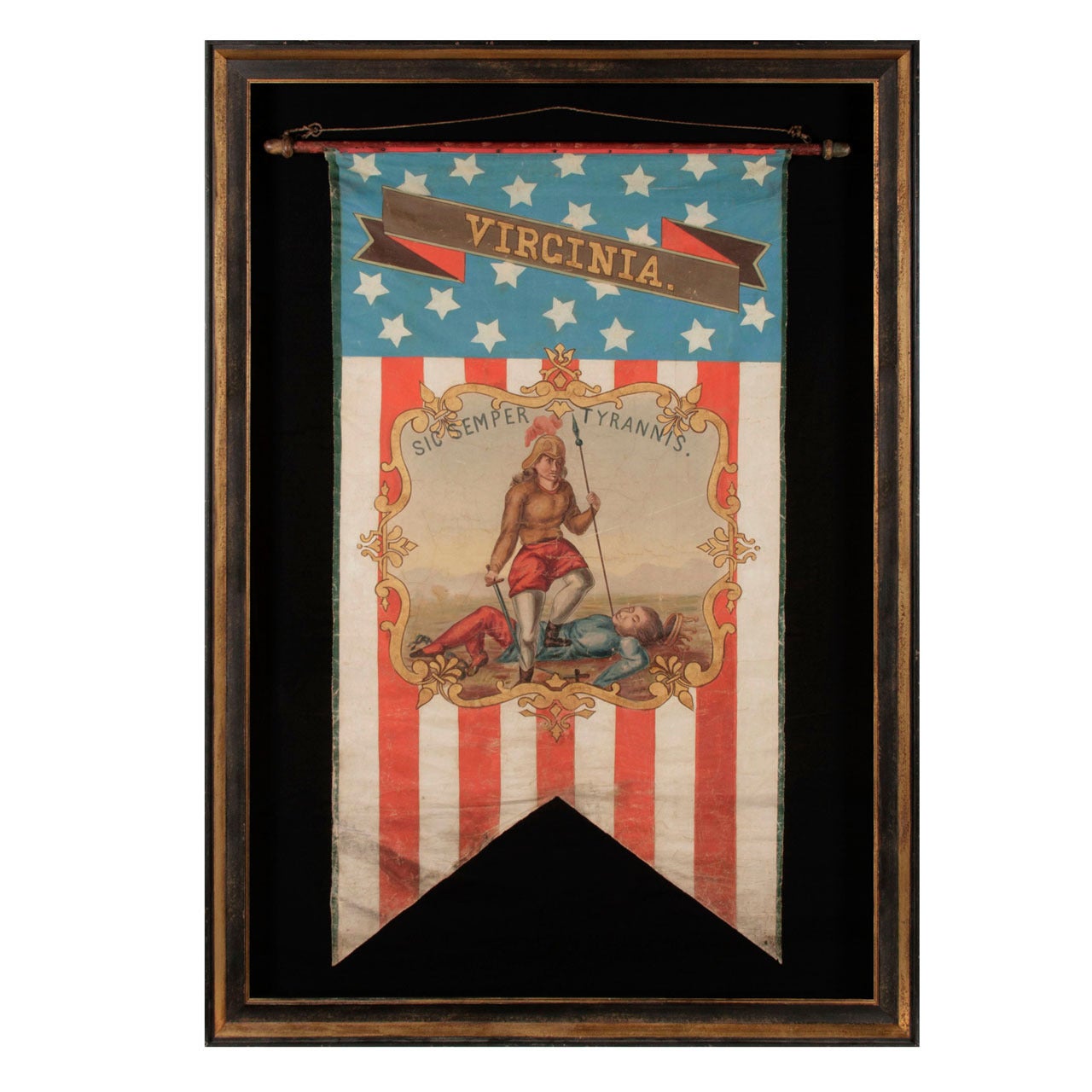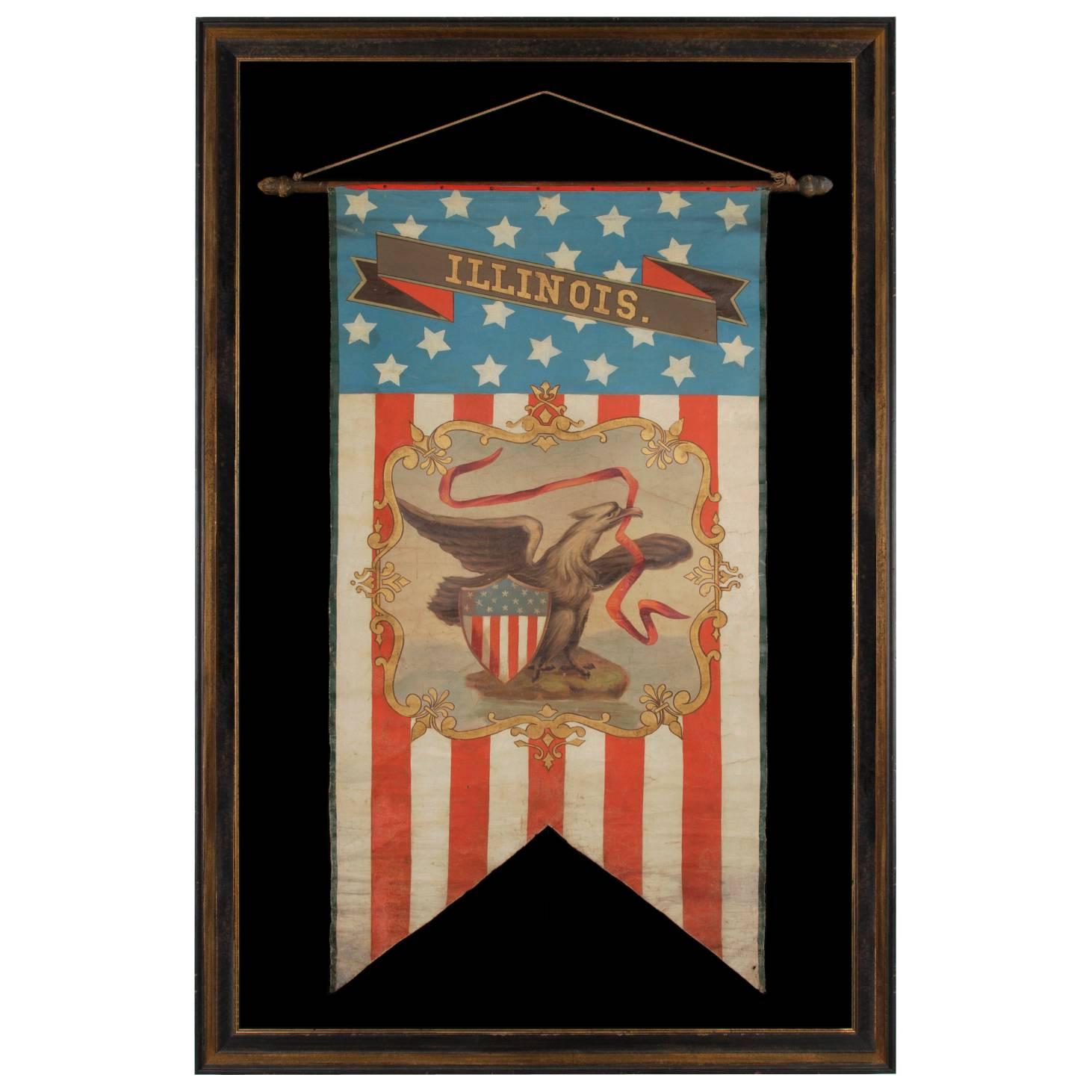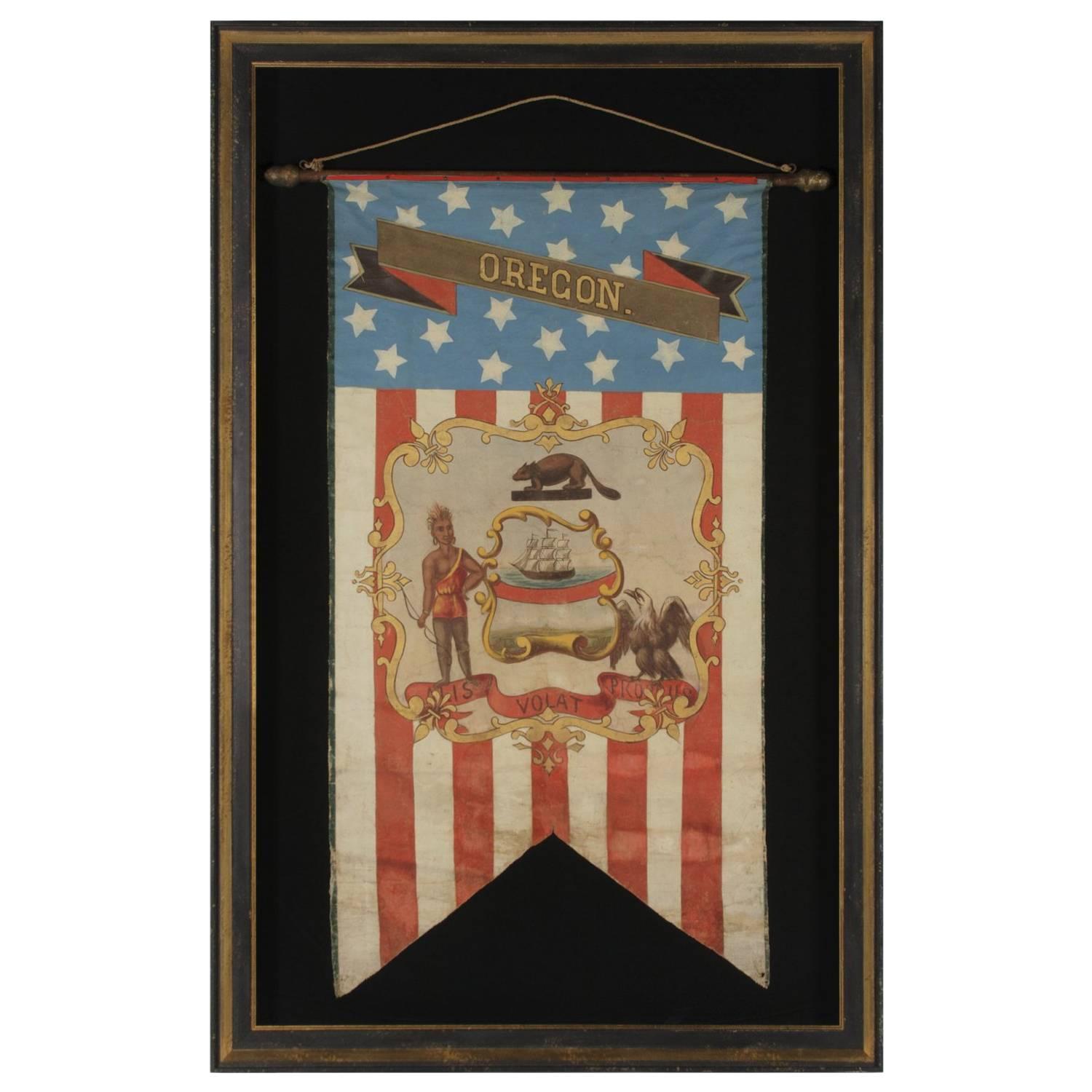Items Similar to Hand-Pained Banner with the Seal of the State of Mississippi, circa 1872
Want more images or videos?
Request additional images or videos from the seller
1 of 10
Hand-Pained Banner with the Seal of the State of Mississippi, circa 1872
About the Item
Unique, hand-painted banner with the seal of the state of mississippi, likely having represented delegates from that state at the 1872 republican or democrat national convention [similar examples identified at both]
Banner with the seal of the State of Mississippi, hand-painted on canvas, with a polychromatic surface, pleasant craquelure, patina, and wear. Retaining its original staff, the banner features a white-painted ground, set between bluish-grey-painted borders to the left and right, with black pinstriping. The lower edge is attractively scalloped, and paint-decorated, to look as if it were fringed with a border of braided, metallic rope. There are heavy metal grommets in the lower two corners, behind which are large, triangular, cotton patches. These are original to the construction. The abbreviate “MISS” is crudely hand-painted on the reverse, in black, at the lowest point. This would have allowed for quick identification among other banners, without having to unroll them.
America secured claim to much of the territory east of the Mississippi River, from Spain, by way of the 1795 Treaty of San Lorenzo (a.k.a., Pinckney’s Treaty). In 1798, some of the lower portion of present-day Mississippi and Alabama became the Mississippi Territory. Almost immediately, even before its formal incorporation, on April 7th, 1798, the Mississippi Territory’s governing body produced a seal, the design of which took the same basic form as the Great Seal of the United States. Adopted on January 19th, 1798, the device featured a spread winged eagle, with a federal shield upon its breast, holding the usual olive branch in its proper right talon, and arrows in its left. The head of the eagle was turned so that its gaze faced the olive branch, as a symbol of peace. Held in its beak was the usual, billowing streamer, with the Latin motto “E Pluribus Unum” (Out of Many, One), above and around which were 13 randomly placed stars, set beneath an arch of clouds. Beyond this, protruding as from behind the entire image, and fanning out in all directions, were rays of sunlight.
The Mississippi Territory was initially comprised of a swath of land that spanned about 1/3 of the present day state, as well as that of Alabama. The line began about half way down their combined expanse, running horizontally across the region. The State of Georgia claimed rights to this area, but could not defend a position of ownership. In 1804, the northernmost half of the two future states was annexed to the Mississippi Territory, with opposing claims made that this was merely part of the 1803 Louisiana Purchase. Then, in 1812, the remaining, southern edge, along the Gulf of Mexico, was finally included. So by that year, the Mississippi Territory encompassed almost all of present-day Alabama.
The Territory gained statehood on December 10th, 1817, and a new seal was adopted about a month later, on January 19th, 1818. This switched the position of the olive branch and arrows, while simultaneously directing the latter inward and down, instead of upward and away. Absent now were the stars, streamer, sun, and clouds, so that only the eagle, arrows, and olive branches remained. Around the perimeter, a descriptive title was added that read: “The Great Seal of the State of Mississippi.”
Just over a year-to-the-day from Mississippi Statehood, the eastern half of the former territory became Alabama, ushered in as an independent state. The Mississippi seal remained constant, however, until 1894, when the state’s Latin motto, “Virtute et Armis” (By Valor and Arms), was added on a banner below, to create the official Mississippi Coat of Arms. This remained in use until 2014, when “In God We Trust” was added to the seal itself, along the lower portion of the circumference.
Painted during the second half of the 19th century, the device illustrated on this particular Mississippi banner, deviates from the official, 1818 version. The eagle, perched above the clouds, on a blue sky, turns its head its proper right, but the points of the arrows, now outward and upward, fall within the general line of its gaze.
Note how the federal shield is purposefully omitted. Made sometime just following the close of the Civil War (1861-1865), most likely during the period of Reconstruction of the South (1865-1876), the absence of such a keen Union symbol is of little surprise. The inclusion of three arrows may likewise be purposeful. Though the meaning is less clear, symbolism of this sort abounds in flags and other patriotic devices of this era.
This banner was once part of a much larger group—a fact evidenced by surviving examples that illustrate other states. In addition to Mississippi, examples of this particular group survive that represent Ohio, Illinois, Pennsylvania, Virginia, and New York. Four of these six I have owned. If I knew nothing else about them, save my examination of the construction and painted surface, I would date them circa 1870-1890. But additional information can be gleaned from the state devices they display, which changed over time.
The Ohio banner, for example, includes a combination of elements present in both the 1866 and 1868 versions. The Illinois banner reflects imagery proposed by Illinois Secretary of State Sharon Tyndale, in 1867, yet never accepted. Because these features were actually rejected, when a new design was approved just a year later, in 1868, one may surmise a very narrow window of possible production.
Knowing that banners in this basic style and scale were displayed to mark the location of state delegates at political conventions, research was undertaken to identify similar forms in 19th century photographs and illustrations. The most likely date seemed to be 1868, but I was already very familiar with the illustration of Tammany Hall in that year, in Manhattan, as decorated for the New York Democrat National Convention, and I knew that this precise style was not illustrated. I was also aware of another variety that may have been used elsewhere in the Democrat venue that year, but employed a swallowtail design and were likewise not a match.
An image of the 1868 Republican counterpart, held in Chicago at Crosby's Opera House, was much more difficult to locate, but when I tracked that down, I discovered it surprising void of the usual buntings and flags.
Turning my focus to engravings from other conventions, I examined everything I could find between 1856 and 1900. The most similar banners I found were displayed in just two halls, both in 1872, just one election year later than suspected. This was the race when incumbent Republican President Ulysses S. Grant, faced off against former Republican power broker and newspaper publisher, Horace Greeley, who ran on an independent ticket, eventually endorsed by the Democratic Party establishment.
The 1872 Republican convention was held in Pennsylvania at the Philadelphia Academy of Music, while the opposing, Democrat convention was held in Baltimore at Ford's Opera House. Detailed illustrations of both survive and clearly display what appear to be white banners, of a similar scale, featuring state crests, lining the balconies at both venues.
Given that the surviving banners of similar form have come from all different sources, it seems likely that they were taken home by delegates following the event. The Mississippi example turned up in Tennessee. The two states border one-another in their northeast / southwest corners. Because banners of this type are extremely rare, and because very little in the way of 19th century flags or patriotic textiles exist that in any way relate to Mississippi, this is an extraordinary object and a remarkable relic of the state.
Mounting: The banner was mounted and framed within our own conservation department, which is led by expert staff. We take great care in the mounting and presentation of flags and related textiles, and have preserved thousands of examples.
The background is 100% cotton twill, black in color, that has been washed and treated for colorfastness. The mount was placed in a black-painted, hand-gilded and distressed Italian molding. A shadowbox was created to accommodate the staff. The glazing is U.V. protective acrylic (Plexiglas). Feel free to contact us for more details.
Condition: There is modest soiling throughout, accompanied by moderate areas of the same, especially in the upper right-hand quadrant of both the device and the white field. There is some creasing, craquelure, and associated paint loss, the latter of which is present in the lower register, from the word “Mississippi” down to the painted fringe. There is a 3-inch, J-shaped tear below the lettering, in the white region, and there is a lateral tear, of similar size, below it, in the painted border, where other, smaller tears are also present, both adjacent and nearby. Several, small, rectangular patches were added. The extreme rarity of state flags and banners, especially from a state like Mississippi, for which almost no 19th century material exists, well-warrants its state of preservation.
- Dimensions:Height: 68 in (172.72 cm)Width: 58 in (147.32 cm)Depth: 4 in (10.16 cm)
- Materials and Techniques:
- Place of Origin:
- Period:
- Date of Manufacture:1872
- Condition:See Item Description.
- Seller Location:York County, PA
- Reference Number:
About the Seller
5.0
Recognized Seller
These prestigious sellers are industry leaders and represent the highest echelon for item quality and design.
Established in 1991
1stDibs seller since 2008
61 sales on 1stDibs
Typical response time: 10 hours
- ShippingRetrieving quote...Ships From: York County, PA
- Return PolicyThis item cannot be returned.
More From This SellerView All
- Hand-Painted Patriotic Banner with the Seal of the State of VirginiaLocated in York County, PAHAND-PAINTED PATRIOTIC BANNER WITH THE SEAL OF THE STATE OF VIRGINIA AND GREAT FOLK QUALITIES: Swallowtail format, patriotic vertical banner beari...Category
Antique 19th Century Political and Patriotic Memorabilia
MaterialsCanvas
- Hand-Painted Patriotic Banner With The Seal of the State of IllinoisLocated in York County, PAHAND-PAINTED PATRIOTIC BANNER WITH THE SEAL OF THE STATE OF ILLINOIS AND GREAT FOLK QUALITIES PROBABLY MADE FOR THE 1868 DEMOCRAT NATIONAL CONVENTION...Category
Antique 1860s North American Political and Patriotic Memorabilia
MaterialsCanvas
- Hand-Painted Patriotic Banner with the Seal of the State of OregonLocated in York County, PAHAND-PAINTED PATRIOTIC BANNER WITH THE SEAL OF THE STATE OF OREGON AND GREAT FOLK QUALITIES, 1861-1876: Swallowtail format, patriotic vertical banne...Category
Antique Late 19th Century American Political and Patriotic Memorabilia
MaterialsCanvas
- Hand-Painted 19th Century Banner with the 1867 Proposed Seal of IllinoisLocated in York County, PAHAND-PAINTED 19TH CENTURY BANNER WITH AN 1867 VERSION OF THE SEAL OF THE STATE OF ILLINOIS, PROPOSED IN THAT YEAR BY THE SECRETARY OF STATE, BUT IN A VARIATION NEVER FORMALLY ADOPTED Banner with the Illinois State Seal, in a rare variation of the design, never adopted. In 1867 Illinois Secretary of State Sharon Tyndale proposed that the phrases in the state motto be reversed. In the wake of the Civil War, (which ended in 1865,) Tyndale suggested that the verbiage be changed from "State Sovereignty--National Union" to "National Union--State Sovereignty,” which made sense given the recent secession of the Southern States, which placed their own interests first. Illinois' own Abraham Lincoln had worked hard to preserve national interests, echoed here in the altering of the language. Though Tyndale’s suggestion was rejected, he was nonetheless charged with creating a new design, which he did and was soon adopted. This displayed the dates of "1818," when Illinois became a state, and "1868," when the seal was officially changed. Interestingly enough, Tyndale did manage to send a message in the new version by turning the word “sovereignty” upside-down , with the surmised explanation that this fit accordingly with the orientation / position of the streamer. The banner is beautifully hand-painted on muslin and retains its original staff. The shape is beautifully scalloped at the bottom edge, which is painted to look as if there is an applied fringe. Most of the elements are congruent with the 1868 version, but there are various differences. Set within a shield-shaped medallion—usually circular—is the expected eagle in a side view, spread wing pose with beak uplifted. The eagle is supposed to be perched upon a rock with one talon, while gripping a Federal shield in the other. Here there is no rock and both talons grip the shield, which displays 13 stars. Note the date of "1867" and Tyndale's preferred order of the wording on the billowing ribbon in the eagle's beak. The foreground of the official design is all grass. Here there are olive branches—a peacetime reference appropriate for a country recovering from war—on a grassy area, set upon a sandy shore before Lake Michigan, with a rising sun on the horizon. Mounting: The banner was mounted and framed within our own conservation department, which is led by masters degree trained staff. We take great care in the mounting and presentation of flags and have preserved thousands of examples; more than anyone worldwide. The background is 100% cotton twill, black in color. The mount was placed in a black-painted, hand-gilded and distressed Italian molding. A shadowbox was created to accommodate the staff. The glazing is U.V. protective plexiglass. Feel free to contact us for more details. Banner - 49" x 56.5" Frame - 67.75" x 59.25" About Jeff R. Bridgman Antiques, Inc.: As an advisor to top museums and collectors alike, Jeff Bridgman is the world's leading expert and source for antique American flags and political textiles...Category
Antique 1860s American Political and Patriotic Memorabilia
MaterialsCotton
- Red Cross Banner with Whimsical Lettering, ca 1917 - 1918Located in York County, PAEXCEPTIONAL RED CROSS BANNER WITH WHIMSICAL LETTERING AND A TERRIFIC SLOGAN, WWI (U.S. INVOLVEMENT 1917-18), ONE OF APPROXIMATELY THREE EXAMPLES PRESENTLY IDENTIFIED EXCEPTIONAL RE...Category
Early 20th Century American Political and Patriotic Memorabilia
MaterialsCotton
- Graphic American Suffragette Poster Commissioned by the Empire State CampaignLocated in York County, PARARE & BOLDLY GRAPHIC AMERICAN SUFFRAGETTE POSTER, COMMISSIONED BY THE EMPIRE STATE CAMPAIGN COMMITTEE, CARRIE CHAPMAN CATT’S GROUP, circa 1915 Extremely rare and boldly graphic Suf...Category
Vintage 1910s American Political and Patriotic Memorabilia
MaterialsPaper
You May Also Like
- Souvenir of the War 1914-15-16-17-18 BannerLocated in Colorado Springs, COPresented is a stunning textile banner from the first World War, dating to 1918. The square tan cotton cloth is embroidered with two crossed flags, the ...Category
Vintage 1910s Australian Political and Patriotic Memorabilia
MaterialsCotton
- Vintage WWII U.S. Navy Patriotic Banner, "Welcome Firemen" Flag, circa 1941-1945Located in Colorado Springs, COThis is a beautifully preserved WWII Navy aircraft carrier banner, emblazoned with a welcome for the ship's firemen. The banner is partially printed and has sewn elements. The flag's field is dyed a rich navy blue, with a resist dyed white stripe and a sewn red stripe at both top and bottom. A large "WELCOME" is resist dyed at center, in big white letters. This is followed by a sewn yellow strip of contrasting fabric, printed with the word "FIREMEN" in blue. Thirteen white stars complete the design of this patriotic piece of WWII and Navy history. The banner retains its original white hoist, with two metal grommets on each side, for ease in display on the ship. Along the center of the hoist is the printed name of "J.S. Sullivan." "Naugatuck, Conn." is printed along the left and the size "2 x3 FT" is printed along the right. The flag maker, Annin, has sewn in its label, boasting "guaranteed defiance fast colors." CONDITION: Very good condition, considering age and past use. Partially printed and hand-sewn flag construction. Some toning to the white of the flag and along the top hoist. Original grommets at left and right of the hoist. The flag measures 36" X 22". Expertly framed on black linen with an antiqued black wood...Category
Vintage 1940s American Political and Patriotic Memorabilia
MaterialsLinen
- Fathers of the Air Service Authentic Signature Collage, circa 1926-1993Located in Colorado Springs, COPresented is a collage celebrating the men who made an early impact on the formation of America’s Air Service. Complete with signatures by Jimmy Doolittle, Tooey Spaatz, Hap Arnold, ...Category
Late 20th Century American Historical Memorabilia
MaterialsPaper
- 1868 Map of the Upper Part of the Island of Manhattan Above 86th StreetBy Wm. Rogers Mfg. Co.Located in San Francisco, CAThis wonderful piece of New York City history is over 150 years old. It depicts 86th street and above. It was lithographed by WC Rogers and company. It was made to show what was the Battle of Harlem during the Revolutionary war...Category
Antique 1860s American American Colonial Maps
MaterialsPaper
- Man of the Sandwich Islands, with His Helmet J. Webber del. J.K. Sherwin Sc.By John WebberLocated in Vancouver, British ColumbiaAn English 18 century engraving titled "Man of the Sandwich Islands, with his helmet " signed .J. Webber del. J.K. Sherwin sc. The subject was sketched in the 1770s by J.K Sherwin S,...Category
Antique Late 18th Century English British Colonial Prints
MaterialsPaper
- Christening of the Prince of Wales Woolwork Picture, Dated 1842Located in Downingtown, PAEnglish Royal Woolwork Picture, Titled E R/ Christening of the/Prince of Wales/Jan 25th 1842. A rare woolwork picture in bands of white, pink, red and green centered with a black and white picture...Category
Antique Mid-19th Century English Folk Art Decorative Art
MaterialsWool
Recently Viewed
View AllMore Ways To Browse
The Seal
The President Furniture
United States Presidents
President Of United States
Antique Memorabilia
Set Of Seals
Italian Seal
I Antique On Line
Metal Seal
Two Centuries Of Black American Art
Warring States Period
Different Types Of Antique Furniture
Great Seal
War Memorabilia
Antique Device
19th Century American Politics
State Flags
The Line By K





